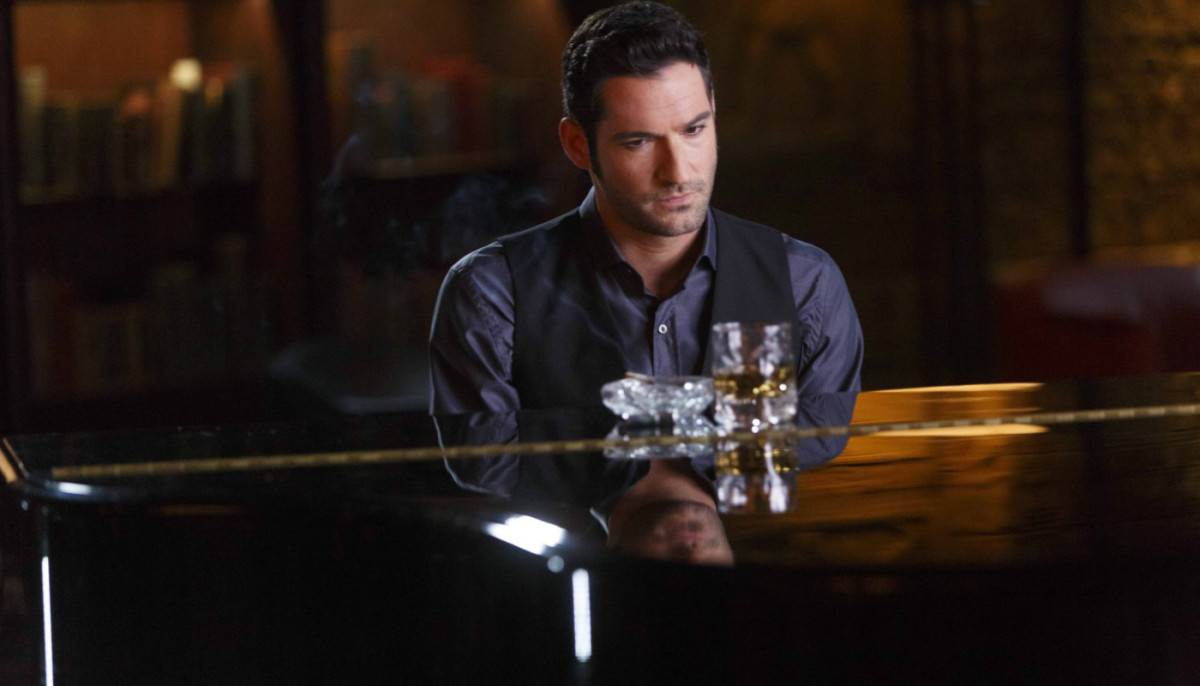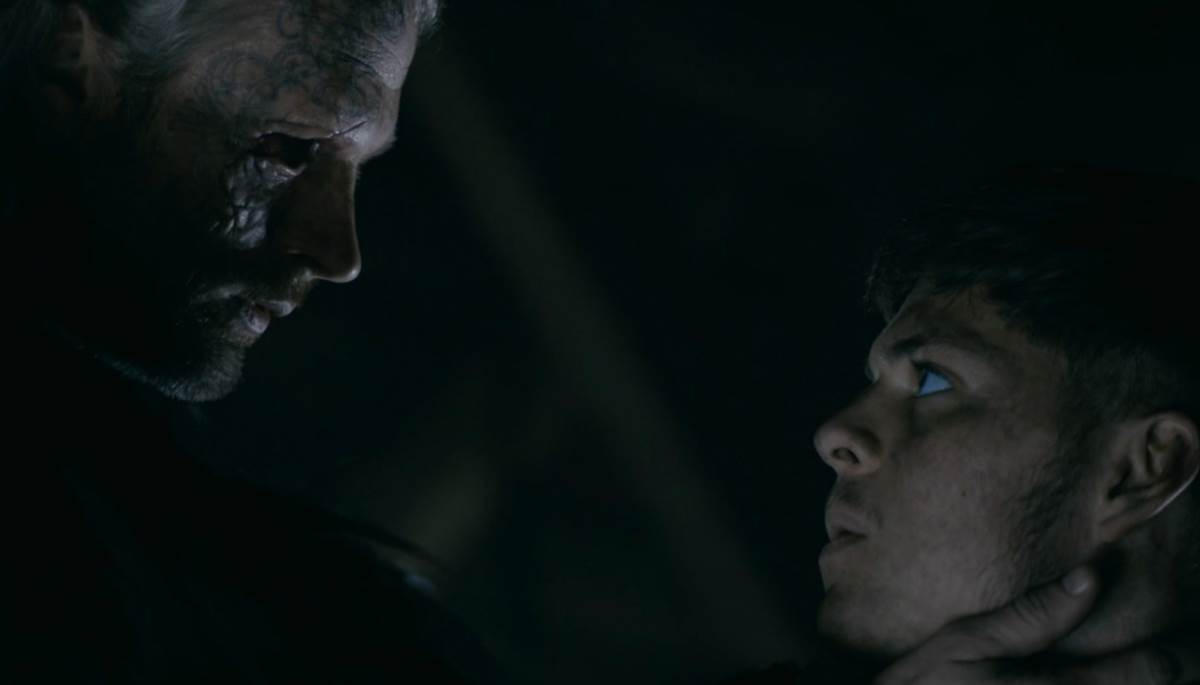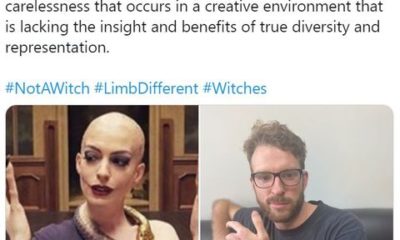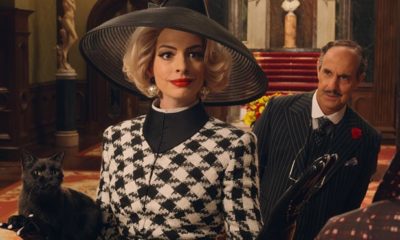Celebrities
The binge-watcher’s guide to witches, witchcraft & wizardry
The witch has been with us throughout Western history and culture. The historical witch is a far cry from her fictional counterparts, although the evolution of her distortion is straightforward enough.
In reality, witches were and are largely healers and herbalists, but most relevant of all, they have been non-conformists who reject mainstream values and norms — particularly religious ones. But the Hollywood version of the witch flies on a broomstick, brews magic potions in her cauldron, and is frequently considered a handmaiden to the Devil.

In the most simple terms, the rejection of societal norms by the real-life witch led to her demonization, inspired the infamous witch hunts, and serve as the breeding ground from which the more unflattering fictional witch stereotypes and tropes are born.

That said, the increasingly complex and modern fictional witch is an ideal vessel for the experience of the outsider, the Other — whether distinguished by gender, race, sexual orientation, or simply a desire to rebel — because, warts and all (or of course, no warts at all), she speaks to a universal human theme: Feeling cast out, or feeling threatened by the outcast, while either way wanting to resolve that break.
We love witches because, in part, they represent our desire to reclaim common ground. A scary sound out in the dark woods could be anything: It’s only when the witch comes hobbling out to the edge of the trees that you can talk to her, ask her name or her favorite food. Tell enough stories about her that she starts to feel like a friend.
RELATED: ‘American Horror Story’ puts the ‘Blair Witch’ in ‘My Roanoke Nightmare’
Through fictional witches, we explore society’s fears of how the disenfranchised, the fringe dwellers and the nonconformists might wield power, and — taken to the extreme — how they might enact revenge for their marginalization. We learn how little power a society is willing to grant them when they do play by the rules, and how we collectively punish outliers for straying too far outside the norm. A witch is someone who both refuses to convert and to be marginalized: You can see how terrifying that must be. How much confrontation — and self-knowledge — is bound in her frightening image.

A central divine archetype across world mythology is the Triple Goddess, which delineates three phases in the life of a woman: Maiden, Mother and Crone. This archetype is reflected in the three phases of the moon (waxing, full and waning), and proves a handy framework for examining the development of women, and witches, alike. With each progression, the witch becomes more of a potential threat to the mainstream as she steps farther away from her naivete and pliability.
With magic, the witch has an advantage that non-magical women do not — but even magic can’t help you, if you exert too much power, or stray too far from your lane. Looking at fictional witches along this timeline reveals a lot about what we value, and what we condemn, in women: From birth to death, page to screen, folklore to film, the witch is all of us — but paradoxically, she’s the part we can’t see or accept. Not without a hell of a lot of work.
The Maiden Witch
As expected in youth, this witch and woman is just coming into her power — and has no idea what to do with that power, just yet. If such a witch doesn’t cause too much trouble, she’s not only tolerated, but often embraced. Witness “Charmed,” “Sabrina the Teenage Witch,” and a slew of other spunky or even downright adorable sorceresses.
RELATED: Marilyn Manson on his ‘Salem’ Season 3 role
Of course, sometimes the Maiden Witch gets the short end because she’s expected to be powerless, vulnerable or invisible. A lot of “poltergeist” stories, films and shows follow this narrative — scratch a “paranormal activity” story and nine times out of ten you’ll find a nubile young girl with no real agenda, standing in the middle of a psychological tornado.

Of course, the Maiden is still fully capable of wielding her power in more profound ways, and in more dramatically complex stories, as she tests the accepted boundaries of her role within society. Here is an awakened Ophelia, navigating treacherous waters; here is a Gossip Girl learning to show her face.

The Maiden Witch is often accepted by society to the extent that she is considered sexually viable. (Motherhood is the next stage of her expected journey, after all.) Her willingness to play along with this expectation of her, or not, and the extent to which she draws her boundaries here, not only informs everything about the way we view her, but also the way she views herself. Marilyn Monroe — from “Some Like It Hot” to “Misfits” to “Bus Stop” — played a lot of Maidens who took on others’ views of herself and her power, sometimes even surviving.

In one of the major early turning points of “American Horror Story: Coven,” a bus full of Brock Turner fraternity types are met with big time retribution after sexually violating an intoxicated and unconscious Madison Montgomery (Emma Roberts). Given the light sentencing with which the real Turner was punished, you could wonder whether magic would provide a more solid form of justice.
These stories, “instant karma” stories where the bully gets his, or the monster is subdued by the Maiden — “Buffy, the Vampire Slayer” literally starts its television premiere with such a turnabout — are undeniably satisfying. But even then, a lot of the time we put the genie back in the bottle (the witch back in the broom closet?): By the end of “Coven,” Madison and almost all of her sisters are meted out the ultimate punishment.

Bonnie Bennett (Kat Graham) from “Vampire Diaries” is beautifully presented as a powerful and benevolent young witch. She makes the ultimate sacrifice by choosing and saving the life of another human over herself. In Bonnie’s case, the beneficiary of her sacrifice happens to be her boyfriend. (The first time.) While complicated territory, to be sure, this does effectively portray the intensity of teenage love, as well as how young women are perhaps more prone (and more encouraged) than young men to temporarily losing themselves in the experience of love.
RELATED: ‘Vampire Diaries’: The 10 best Bonnie Bennett scenes of all time
But Bonnie’s story hardly ends there: she then undergoes a classic Underworld journey, and ultimately experiences a rebirth. Hers is a heroine not ruined by love, but rather strengthened and matured by it. This arguably is a win-win for the individual and the greater good, which is the best of both worlds.

At the other end of the spectrum we find “The Craft”: A cult classic that centers on four young women experimenting with their power within the teenage microcosm of society, high school.

It could be argued that Nancy (Fairuza Balk) is penalized the most for pushing back the hardest against societal expectation. While she does kill an overly amorous teenage boy, this boy was on the verge of committing date rape. There’s no use in minimizing the severity of her crime, nor is there a fair argument to be made that she should have gotten away with her crime.

But interestingly, it’s Sarah (Robin Tunney) — the witch who proves dutiful to parents and community in the end –who walks away the hero and gets to retain her powers. To the extent that we care what Maidens do, then, we care that they come home to us in the end.
Eugenides’ classic non-fantasy “The Virgin Suicides” offers an example of what can happen when the Maiden doesn’t do this of her own volition, just as Hawthorne’s “Scarlet Letter” is really about the consequences for a Mother who refuses to return from the wilds. Either way, how the Maiden Witch fares in various stories sets the stage for the greater compliance that will be expected of her by society in the next stage of her journey.

The Mother Witch
Whether or not the woman can or does become a mother literally, the witch in this phase of life is valued by the extent to which she is willing to nurture, and even sacrifice herself for, others. The self-sacrifice inherent in motherhood is often at odds with self-expression and self-determination, and the struggle becomes a lot more intense. We tend to applaud the individual willing to sacrifice the self for the greater good — regardless of whether it’s the most empowering choice for individual in question.
In “Salem’s” pilot episode, Mary Sibley (Janet Montgomery) — unmarried and pregnant — finds herself in a dangerously precarious position within her Puritan community. While deciding what do with the child conceived with her lover, a heartbroken Mary is told by Tituba (Ashley Madekwe), “You have no choice.” As the series progresses, it’s all the more impressive to witness Mary craft a life for herself (pun intended) in which she will never be powerless again.
In 17th century Salem, of all places, this is no mean feat. Her move isn’t entirely a selfless one, either — she’s well aware of the treatment awaiting her bastard child, along with herself, in such a setting. While her portrayal as non-Christian within a Christian community may make her a less palpable heroine to those who prefer a literal reading, the fact that Mary opts for power and self-determination despite this marginalization makes the character a force to be reckoned with.

In “Sleepy Hollow,” Katrina (Katia Winter) aligns herself with her son over her husband and society. To be fair, her son is engaging is something a little more troublesome than acting out — he’s facilitating the apocalypse — but out of maternal guilt, Katrina sides with her son — and swiftly, summarily, relegated to the role of villain (after spending her time on the show almost entirely in a passive, housebound, Maiden role).

With regards to how a mother nurtures the next generation, society ultimately requires compliance. By making a personal choice over the popular one, Katrina plays the mother role a little too well, and must pay.
RELATED: What kind of monster is Sibyl in ‘Vampire Diaries’ final season?
In contrast, there’s a surprising upheaval of the mother type in “Supernatural’s” Rowena (Ruth Connell). This non-maternal character displays tremendous flair — plenty of Mae West-ish one-liners and chutzpah — while being the bane of her son’s existence… Her son Crowley, of course, who happens to be the King of Hell.

Not one to chair the local PTA meeting unless there’s something in it for her (although it begs the delightful question of what a PTA meeting in Hell might actually look like), Rowena not only defies traditional expectations of the Mother, but she also exerts her power while having fun.

The outsider — which a non-maternal or otherwise occupied mother most certainly is — is hardly ever allowed to enjoy herself, which makes Rowena particularly fun to watch in turn.
RELATED: Will Charlotte’s hatred of humanity hurt her son ‘Lucifer’s’ relationships?
“Game of Thrones’s” Melisandre is one of the most compelling examples here, giving birth to no less than a shadow demon who assassinates a political rival. Using her power to breathtaking effect, to orchestrate regime change, Melisandre is a figure on a chessboard upon which she herself can never become queen, so she does the next best thing: Makes herself indispensible to whomever is positioned to rule. While highly flawed in her choices (aren’t we all?), she’s nonetheless a spellbinding example of the witch who can take care of herself even in the most brutal environment.
The Crone Witch
In many regards, the elderly are the ultimate outsiders of modern society: To be mortal, infirm, dying, falling apart is a nightmare that begins to effect us at a younger and younger age. The crone stereotype, which the likes of Disney have made quite a meal of, speaks to these fears — and to the fears of what a woman will do when her use has run out and her free time starts to grow.
The scary old hag whose sole purpose is to curse the young and the beautiful is an embodiment of Time itself, coming after us all — but she’s also a place to put the discomfort that aging women are supposed to make us feel.
RELATED: Tricia Helfer: ‘Lucifer’s’ mom is just misunderstood
This is the life phase that ought to present both woman and witch in her full glory, wisdom and insight — yet it’s the stage that her value is at its lowest, and most terrifying. When all you are is sexual viability, or nurturing motherhood, the lack of those things means a mysterious agenda: We literally cannot imagine what a woman would think about, or plan, without those distractions, and so we assume dark magic.
The elder witch is a monster, because we don’t have a word or a concept for the truth. At the age when a woman most knows her own mind and isn’t afraid to speak it — to wield her full “power” in life, without risking the consequences a younger woman would — it’s this phase of witchhood (and womanhood) that terrifies the mainstream the most. Witch stories told in the modern era reflect this ongoing bid for relevance and power by the outsider; to find a way to leverage that terrifying lack of value back into something useful.

But those stories, too, are changing: It isn’t just Rose, Blanche and Dorothy (innocent Maiden, lush Mother, wise Crone) that give us other images of womanhood through time: The forced marginalization of the Crone Witch plays out beautifully in “Penny Dreadful’s” most moving episode, “The Cut-Wife,” in which grand dame witch Madame Kali and her coven of Night Comers arrive, to take down the Cut-Wife (Patti Lupone).

The Cut-Wife, who has already accepted her marginalization with grace, is nonetheless punished for her refusal to play by either her village’s or her rival’s rules: Her sister Madame Kali despises her for not sharing her coven’s ambition to rule the weak-minded masses, while the hypocritical townsfolk she treats despise her for offering medical services, including terminations of pregnancy, from which they all benefit in one secret way or another.

Through the Cut-Wife, married straying husbands are able to dispatch evidence of their dalliances, randy young men dispatch responsibility for their behavior, and the women — caught between desire and a double standard — are granted a secret do-over, of sorts. Where even a Queen of Witches like Madame Kali must work in the shadows of their Victorian society, the Cut-Wife wants only to live in relative peace, at the village’s literal edge — but then, an outlier with no allies is often the very one to open her door: To behold the lost and unforgiven; to behold the angry mob.
She replenishes from the outskirts, reassures outcasts, and she takes a dark justice from the shadows when necessary: Her wisdom is terrifying, and it shakes the world — but it is the world’s foundation, too.

Stockard Channing and Dianne Wiest, in “Practical Magic,” are a much more delightful and empowered variation on the Crone in her full glory. Still presented as fringe-dwellers, these aunties take pride in their rebel status, and don’t suffer for that pride: A very rare thing in traditional depictions of this type, and one that finally bears fruit, as the end of the film shows a two-way tolerance, blooming adoration, and celebration of the community between the story’s town of Muggles and family of witches.

The fictional witch, for a very long time, was in a double-bind: Punished for her confidence, in her nonconformity and personal power, and punished for remaining quiet and afraid. But as more and more people have access to tell their own stories, and other views on these realities and lives, the stories open up. What was once a blue-moon proposition, the rare celebration of a woman’s power and strength that just might elude the storyteller’s grasp — or even a subtle, subversive or coded version of same — is now a fairly common occurrence.
As above, so below.
The stories we tell — about ourselves, and each other — inform the stories we tell. Hear your whole life that you’re better off small, alone, invisible or powerless, and there’s no real reason to look for an alternative. But by the same token, all it takes is one witch to crack that story open, and let a little light in. Enough of those, over enough years, and suddenly magic — whether a women’s power, an outsider saying hello, a black sheep back in the fold — isn’t the scariest thing you can think of.
Pretty soon, there’s nothing scary about it at all.
“The Vampire Diaries” returns Friday, Oct. 21 at 8:00 p.m. ET/PT on the CW; “Supernatural” airs Thursdays at 9:00 p.m. ET/PT on the CW; “Salem” airs Wednesdays at 9:00 p.m. ET/PT on WGN beginning Nov. 2; “Sleepy Hollow” returns to Fox in 2017; and “American Horror Story: Roanoke” is currently airing Wednesdays at 10:00 p.m. ET/PT on FX.
Share this:
You may like
-


What to Watch on Thanksgiving Weekend: TV Viewing Guide
-


Strictly star on The Witches “carelessness” over limb distinction
-


Anne Hathaway Apologizes After ‘Witches’ Backlash From
-


Teen Witches Tackle Toxic Masculinity in Clever Sequel
-


Memorial Day Movie Viewing Guide: Our Favorite Military
-


The Watcher [Blu-ray]
Gary Marsh to Exit as Disney Branded Television President,
‘The Many Saints of Newark’ Magical and Burdensome, Reviews



‘Shang-Chi’ Adds $21 Million as Box Office Slows Down



‘The Eyes of Tammy Faye,’ ‘The Card Counter’ Revive Indie



‘Trust Me, You Don’t Want This’
Trending
-



 Movies News4 years ago
Movies News4 years agoVenom struggle scene footage with out CGI is sure to make you giggle
-



 Celebrities8 years ago
Celebrities8 years agoTV Query: Can ‘Lucifer’s’ Tom Ellis play the piano in real life?
-



 Movies News8 years ago
Movies News8 years agoAubrey O'Day Reveals Pauly D Has His Penis Pierced: ''We've Been Having Rea…
-



 Celebrities7 years ago
Celebrities7 years ago‘Vikings’: Who’s the man with one eye? We know the answer











